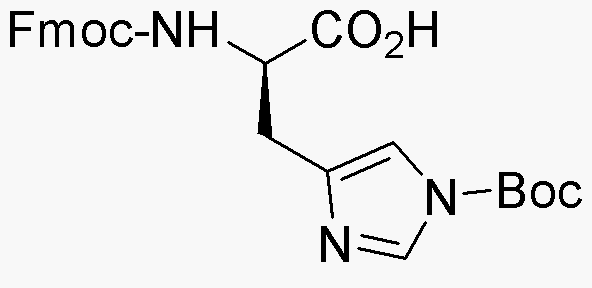Na-Fmoc-Nim-Boc-D-histidine is widely utilized in research focused on:
- Peptide Synthesis: This compound serves as a crucial building block in the synthesis of peptides, particularly in the development of therapeutic proteins and vaccines, enhancing the efficiency of the process.
- Drug Development: It plays a significant role in drug formulation, especially in creating targeted therapies for various diseases, including cancer, by improving the stability and bioavailability of active pharmaceutical ingredients.
- Bioconjugation: The compound is used in bioconjugation techniques, allowing researchers to attach drugs or imaging agents to biomolecules, which is essential in developing targeted drug delivery systems.
- Research in Biochemistry: It aids in studying protein interactions and functions, providing insights into cellular processes, which is vital for understanding diseases and developing new treatments.
- Custom Synthesis: Due to its unique properties, it is often employed in custom synthesis projects, enabling researchers to create tailored compounds for specific applications in various fields, including materials science and nanotechnology.
General Information
Properties
Safety and Regulations
Applications
Na-Fmoc-Nim-Boc-D-histidine is widely utilized in research focused on:
- Peptide Synthesis: This compound serves as a crucial building block in the synthesis of peptides, particularly in the development of therapeutic proteins and vaccines, enhancing the efficiency of the process.
- Drug Development: It plays a significant role in drug formulation, especially in creating targeted therapies for various diseases, including cancer, by improving the stability and bioavailability of active pharmaceutical ingredients.
- Bioconjugation: The compound is used in bioconjugation techniques, allowing researchers to attach drugs or imaging agents to biomolecules, which is essential in developing targeted drug delivery systems.
- Research in Biochemistry: It aids in studying protein interactions and functions, providing insights into cellular processes, which is vital for understanding diseases and developing new treatments.
- Custom Synthesis: Due to its unique properties, it is often employed in custom synthesis projects, enabling researchers to create tailored compounds for specific applications in various fields, including materials science and nanotechnology.
Documents
Safety Data Sheets (SDS)
The SDS provides comprehensive safety information on handling, storage, and disposal of the product.
Product Specification (PS)
The PS provides a comprehensive breakdown of the product’s properties, including chemical composition, physical state, purity, and storage requirements. It also details acceptable quality ranges and the product's intended applications.
Certificates of Analysis (COA)
Search for Certificates of Analysis (COA) by entering the products Lot Number. Lot and Batch Numbers can be found on a product’s label following the words ‘Lot’ or ‘Batch’.
*Catalog Number
*Lot Number
Certificates Of Origin (COO)
This COO confirms the country where the product was manufactured, and also details the materials and components used in it and whether it is derived from natural, synthetic, or other specific sources. This certificate may be required for customs, trade, and regulatory compliance.
*Catalog Number
*Lot Number
Safety Data Sheets (SDS)
The SDS provides comprehensive safety information on handling, storage, and disposal of the product.
DownloadProduct Specification (PS)
The PS provides a comprehensive breakdown of the product’s properties, including chemical composition, physical state, purity, and storage requirements. It also details acceptable quality ranges and the product's intended applications.
DownloadCertificates of Analysis (COA)
Search for Certificates of Analysis (COA) by entering the products Lot Number. Lot and Batch Numbers can be found on a product’s label following the words ‘Lot’ or ‘Batch’.
*Catalog Number
*Lot Number
Certificates Of Origin (COO)
This COO confirms the country where the product was manufactured, and also details the materials and components used in it and whether it is derived from natural, synthetic, or other specific sources. This certificate may be required for customs, trade, and regulatory compliance.


